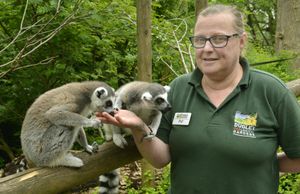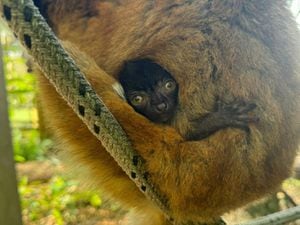Dudley Dudley Zoo celebrates spring baby boom
The pitter-patter of tiny feet has become louder at Dudley Zoo where proud keepers have witnessed a spring baby boom.

From an adorable pigmy marmoset to twin ring-tailed lemurs - the attraction has been abuzz with excitement over almost a dozen new arrivals in as many weeks.
And no-one is more pleased than Pat Stevens, who is the zoo's head of upper primates and is monitoring the progress of nine newborns in her care.
"It lifts your spirits. It's been busy but everybody is doing very well. With the babies, we tend to leave the parents to it. We don't like to interfere with them. We're just here to make sure they are feeding well and looking healthy," she said.
The first to be welcomed into the world in the primates section were a baby lar gibbon and a black and white ruffed lemur on March 14.
Born to mother Meo and father Huggy, the young gibbon has been named Gary. He joins their other offspring six-year-old Penny and three-year-old Indah.
Keepers chose the names for the youngsters and like they like some memorable. "Gary seemed to suit him. He's coming along nicely and feeding well. He's doing great," said Pat, who is married to the zoo's head gardener Carl Stevens.
Handsome black and white ruffed lemur Zeus was the first to be born at the attraction for 21 years.
He was born to first-time mother Olivia, aged 17, and father Broom, 25, and his arrival took staff by surprise.
"We never expected Broom and Olivia to have a baby. They've been together for four or five years and nothing has ever happened. It really was a big surprise but a nice surprise," said Pat.
"Zeus is probably my favourite - he's definitely got attitude and he doesn't like me but he's just adorable," she added.
There was double-trouble on March 18 with the arrival of twin ring-tailed lemurs Sulu and Sarek, named after characters from Star Trek. "They have not been sexed yet but we think the names will be fine for a boy or a girl," said Pat, aged 50.
They were the 13th and 14th babies born at the zoo from mother Phoebe and their father is Frank.
Just a few days later there was a new face in the capuchin enclosure. The youngster was born on March 23 to mother Dinya and father Willow and not yet been named.
A tiny black lemur appeared in the one-acre Lemur Wood walk-through exhibit the next day on April 24.
The youngster is the second black lemur baby born at the zoo in a year as Barbara and father Bryan had a little girl, Kimmy, on May 15 last year.
The black lemur births are extra special to Dudley Zoo as we play a key role in the conservation battle of the vulnerable species. We’re the European Endangered Species Programme (EEP) studbook holder for the entire European captive population.
In April there were also two births in the Castle Creatures exhibit, housed in the 11th century Dudley Castle, with two Seba’s short-tailed bat mums each having a baby.
While the latest arrival has been a minute pygmy marmoset, the world’s smallest monkey, was born on May 1 to mum Pam and dad Hendrix. The little one is Pam’s 14th baby and is doing very well.
“Pam is a very experienced mum and usually gives birth to twins. This is the first time she has delivered a singleton for a few years. The pygmy marmosets are one of my favourites too.
"Despite their size, they've got a lot of attitude. If you go into their enclosure, they are all in your face. They are very playful and are always rolling about on the floor," said Pat, who has worked at the zoo for the last 19 years.
Outside of the primates section, visitors can also spot two young Barbary sheep. The first one, a boy called Windsor, was born on March 25. The second one arrived on April 30 in front of a visitor Kelly Daly.
She took photographs shortly after the birth and said she felt very lucky to have been there at the time. Curator Richard Brown said: “It’s a very exciting time and our dedicated keepers do a brilliant job of looking after some of the world’s rarest animals.”





